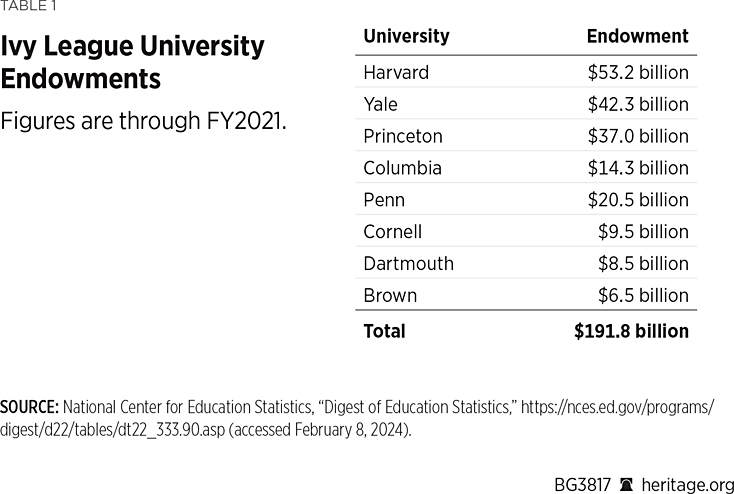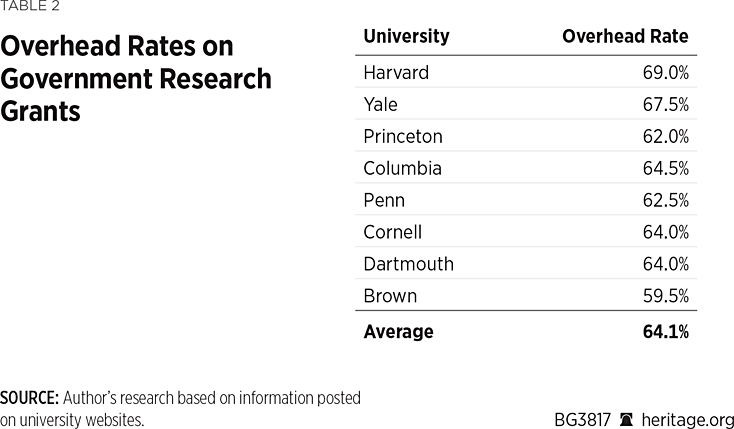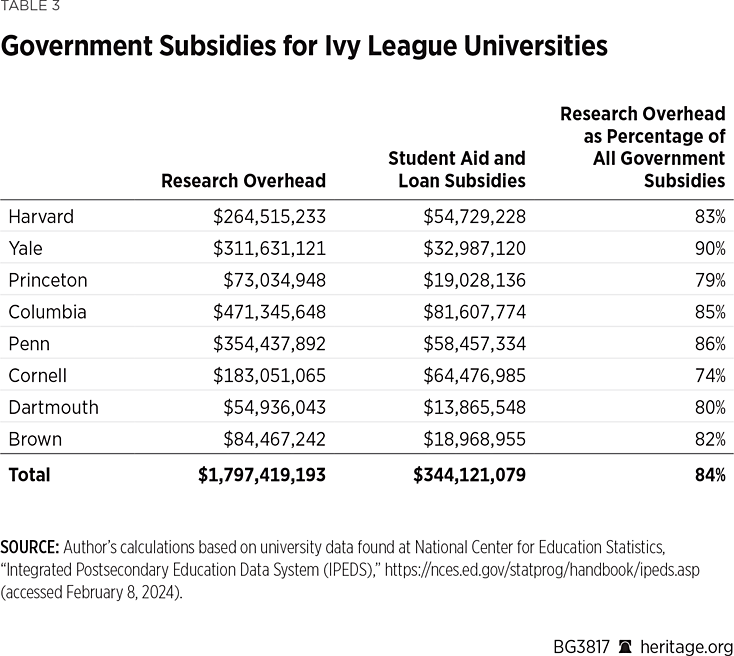The federal government provides enormous subsidies to the wealthiest universities in the country. People may imagine that the bulk of these subsidies assist low-income students in covering the high and rising costs of attending these universities, but that is not what the federal government primarily funds. The largest type of subsidy that wealthy universities receive is in the form of payments for overhead costs on federal research grants. During fiscal year (FY) 2022, Ivy League universities received $1.8 billion for overhead on government-funded research grants. That represents 84 percent of the total amount of government subsidy those universities received.
Research grants are not subsidies, because every dollar received has to be spent according to the terms of the grant. But for every dollar Ivy League universities receive for research, they charge the government an additional 64 cents, on average, for overhead. Ostensibly, overhead covers things such as the cost of the building where the research takes place and the electricity that keeps the lights on. But universities do not have to account for the use of these funds for overhead. They can be used for virtually any purposes that university administrators prefer, and, as past research has demonstrated, these discretionary uses of overhead funds include building diversity, equity, and inclusion (DEI) bureaucracies and indulging whatever other ideological activity they wish.REF The money that directly funds research may not be a subsidy, but the overhead—or, as it is often called, “indirect” money—is clearly a subsidy, because it is almost entirely fungible and unaccountable.
The eight universities in the Ivy League receive $1.8 billion each year from taxpayers despite the fact that these universities are sitting on $192 billion in endowment funds. If they need money for buildings and electricity, donors have already given them plenty. There is no need for taxpayers to give the richest universities $1.8 billion each year to cover the costs of buildings that their donors have already enabled them to maintain and update.
It makes no sense for taxpayers to continue to subsidize the construction of new research infrastructure at wealthy universities unless there is a specific justification, such as supporting the construction of a particular telescope, laser, or particle accelerator. Giving taxpayer money to wealthy universities that already have plenty of resources for buildings, laboratories, and maintenance is simply providing those institutions with a slush fund that they can use for any purpose, including those hostile to taxpayers’ preferences and interests.
Just as the tax code often phases out subsidies such as the child tax credit for wealthier individuals, governmental programs that fund university research could phase out the provision of overhead funding for wealthier universities. Arguably, universities with more than $5 billion in endowment do not require any money from taxpayers to build and maintain their research infrastructure. And perhaps the rate for overhead could be capped at 15 cents for every dollar meant for research for universities with more than $2 billion in endowment—significantly less than the overhead rates in excess of 60 cents now common at universities.
There is no reason to fear a mass abandonment of research if taxpayers fail to lavish extra money for overhead on universities that already have the research infrastructure. Those universities have reputational reasons to conduct research even if doing so does not generate a slush fund for administrators. And there is reason to hope that redirecting overhead subsidies outside of the few dozen universities that are too rich to need it might help spread research expertise more evenly around the country, improving educational and economic opportunities in large parts of the country that currently have their best researchers hired away to the coasts by the richest universities.
Capping and eliminating overhead subsidies is likely to be broadly popular. The only opposition is most likely to come from the highly paid administrators and researchers at wealthy universities. But universities and researchers at other institutions would be helped or unaffected, because their overhead funding would not change or might increase. Those interested in maximizing the benefits of government-funded research would also be helped or unaffected because the nation’s total capacity to produce research would remain unchanged or expand. And most importantly, taxpayers would benefit by no longer having to pay for unaccountable slush funds at wealthy universities that do not need that money to do their jobs.
The Origin and Purpose of Overhead on Research Grants
The federal government began systematically funding scientific research at universities following World War II. Several federal agencies pay for this research, including the National Science Foundation, National Institutes of Health, Office of Naval Research, and U.S. Department of Education. From the beginning, federal sponsors of research provided some funds for overhead with their research grants.REF
At first, the rate was capped at 8 percent, meaning that for every dollar supporting itemized research costs, universities could get an additional 8 cents to cover the fixed costs of building and maintaining a research infrastructure. That cap was raised to 15 percent and then 20 percent. In 1966 the cap was removed and universities were simply allowed to set rates based on an arbitrary cost formula that is easily inflated but provides a “patina of objectivity and technical respectability.”REF
Once the cap was removed, the rate universities charged for overhead rose dramatically so that by 1990 the rate at Stanford was 70 percent. A series of scandals revealed that these overhead funds were being used for things such as yachts and redecorating the offices of university administrators. Rates dropped below 50 percent before creeping up over 60 percent in recent years.REF
There is no question that research activity involves both direct costs that can be attributed to the specific project and indirect costs that have to be spread across the entire set of research activities at a university. The amount required for these indirect or overhead costs is ambiguous and has clearly varied dramatically across time.
Universities that have less private support may need public assistance in building and maintaining their research infrastructure if it is a priority to increase total research activity. But universities that have generous private support, as indicated by very large endowments, do not require public assistance to have significant research capacity. To put in perspective how rich U.S. universities can be, Harvard’s endowment of $53 billion exceeds the gross domestic product of 124 countries, including Tunisia, Uganda, Bolivia, and Estonia.REF The $192 billion they have collectively is greater than the entire annual budgets of 48 states. (Only California and New York spend more than what the Ivy League has in the bank.REF)
With endowments that big, they have enough funding to build and maintain research infrastructure. And given the nonprofit status these universities have been granted to pursue the discovery and dissemination of knowledge, they have an obligation to use their resources to build and maintain research infrastructure even if taxpayers do not provide them with additional funds for that purpose.
Data and Methodology
Information on the resources Ivy League universities have at their disposal from private donations as well as from government funding is readily available. The U.S. Department of Education’s Digest of Education Statistics reports the 120 largest university endowments as of the end of fiscal year 2021.REF All eight universities in the Ivy League rank among the top 26 in terms of the size of their endowments. As can be seen in Table 1, Ivy League endowments range from $53.2 billion for Harvard to $6.5 billion for Brown.

In total there are 32 universities that had more than $5 billion in endowment as of the end of FY 2021. A total of 70 universities had $2 billion or more.
Information on the extent of government subsidies for Ivy League universities, including the amount they receive for overhead on government research grants, is available from the “Institution Profiles” in the U.S. Department of Education’s Integrated Postsecondary Education Data System. Those profiles contain information on student financial aid, enrollment, and finances for each of the Ivy League universities.REF
The profiles for each university describe the percentage of students receiving aid, including Pell Grants, and the average dollar amount of that aid. Multiplying enrollment by the percentage of students receiving aid and by the average dollar amount of that aid provides the total amount of government aid assisting students for each university.
Similarly, the profiles describe the percentage of students receiving student loans and the average amount of those loans. Since loans are only partially subsidized—given that, under most circumstances, students need to pay them back—the Congressional Budget Office has estimated that roughly 26 percent of loan amounts should be considered subsidies.REF Multiplying enrollment by the percentage of students receiving loans, the average amount of those loans, and 26 percent produces the total value of assistance to students in the form of government loans.REF
The profiles also list the amount of government grants and contracts per student. Multiplying that by full-time enrollment yields the total amount of government grants and contracts. To isolate the portion of that amount that is for overhead, the rate each university charges for overhead can be obtained from each university’s website.REF (See Table 2.)


The results of all these calculations can be found in Table 3. The amounts that Ivy League universities receive for overhead on research grants range from $55 million for Dartmouth to $471 million for Columbia. In total, these eight universities annually receive $1.8 billion for overhead on research grants, averaging $225 million for each Ivy League institution.
The amount of subsidies these universities receive for overhead on research grants dwarfs the amount they receive from the government to subsidize student attendance. The amount each university receives in aid and loan subsidies ranges between $14 million for Dartmouth and $82 million for Columbia. In total the eight Ivy League universities receive $344 million for student aid and subsidies on loans compared to $1.8 billion for overhead on government research grants. Of all of the government subsidies these universities receive, 84 percent of it comes in the form of overhead on government research grants and only 16 percent in the form of aid or loans to students.
Discussion and Policy Recommendations
Some have noticed the outsized endowments of these and similar universities and proposed a number of reforms to ensure that these institutions are not simply operating as tax-advantaged hedge funds with small universities attached. Some have advanced sensible solutions, such as removing the tax exemption for rent or fee-based dorms, dining halls, and other activities that are effectively apartment and restaurant businesses that are not necessary for the teaching and research purposes of a nonprofit organization. Others have wondered whether it might be desirable to tax those endowments where they are not fully being used for public benefit. Taxing endowments, however, sets a bad precedent for expanding asset or wealth taxes more broadly, which is generally undesirable economically and can easily become confiscatory. Before considering taxing university endowments, the government should significantly curtail providing additional taxpayer subsidies for the purposes that the endowments can already cover.
The largest type of government subsidy Is overhead for government research grants. If that subsidy were eliminated for the 32 universities with more than $5 billion in endowment and capped at an overhead rate of 15 percent for the 38 universities with between $2 billion and $5 billion in endowment, taxpayers would save several billion dollars each year by avoiding paying for something that those wealthy universities can already purchase for themselves.
Doing this would not reduce the total amount of research being conducted at universities but might reallocate some of it away from the few dozen richest universities primarily located on the coasts and toward the hundreds of universities capable of research spread throughout the country. Under the current system, Ivy League universities can use their large endowments to attract many promising researchers working at less wealthy universities. In exchange for that modest investment in salaries, Ivy League and other wealthy universities lock up billions in taxpayer subsidies to themselves over and above the research costs.
Concentrating researchers across a multitude of disciplines in just a handful of rich universities is not in the public interest. Having those researchers more evenly dispersed throughout the country allows more students to benefit from the education of leading scientists and opportunities to participate in their research. In addition, the economic benefits of this research activity are being concentrated in a handful of coastal cities, and those rich few universities (and surrounding communities) are only getting richer with the help of taxpayer dollars.REF
In addition, research grant overhead provides university administrators with slush funds to indulge ideological pet projects, such as building larger DEI bureaucracies.REF Having large slush funds at already wealthy Ivy League universities has greatly contributed to the campus extremism and radicalism that has shocked much of the country following the October 7 attack by Hamas on Israeli civilians. As previous research has demonstrated, DEI bureaucracies exacerbate antisemitism.REF And, in general, organizations that have too much money on their hands and virtually no accountability have a tendency to indulge in foolish and sometimes dangerous ideas that “only an academic could love.”
Stop Subsidizing Nonsense
The government can curtail nonsense, save taxpayers money, and reallocate research subsidies more evenly throughout the country by eliminating and capping research overhead funding for the wealthiest universities.
Jay P. Greene, PhD, is a Senior Research Fellow in the Center for Education Policy at The Heritage Foundation.



